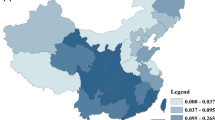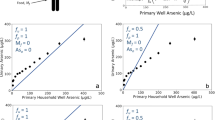Abstract
Background
Rice can be a source of arsenic (As) exposure, causing health impacts after ingestion.
Objective
This study analyzed health risks due to As exposure through rice consumption, focusing on both bioaccessible (bAs) and total (tAs) As levels.
Methods
Monte Carlo simulations were applied to determine health risk uncertainties and to analyze factors influencing health risks.
Results
Cooked white and brown rice contained lower tAs and bAs than FAO/WHO standards of 0.20 and 0.35 mg/kg, respectively. As became less bioaccessible after cooking (14.0% in white rice and 18.5% in brown rice). Non-carcinogenic effects (MOS < 1) were found in 5% of children. Carcinogenic effects (MOE<100), especially lung cancer, were found in 75% of adults, with a probable incidence of 7 in 1,000,000. The lowest and highest annual cancer cases were 18 in 10,000,000 adolescents and 15 in 1,000,000 adults, respectively. The risks were mainly affected by body weight and bAs concentration.
Significance
The results identified a certain risk level of non-carcinogenic effects in children and adolescents as well as carcinogenic effects in adults. The per capita consumption of rice in Thai adults should be reduced to prevent incidences of lung cancer.

This is a preview of subscription content, access via your institution
Access options
Subscribe to this journal
Receive 6 print issues and online access
$259.00 per year
only $43.17 per issue
Buy this article
- Purchase on Springer Link
- Instant access to full article PDF
Prices may be subject to local taxes which are calculated during checkout

Similar content being viewed by others
References
National Bureau of Agricultural Commodity and Food Standards. Food consumption data of Thailand (in Thai). Ministry of Agriculture and Cooperatives, Bangkok. 2016.
Food and Agriculture Organization of the United Nations and the World Health Organization (FAO/WHO). General standard for contaminants and toxins in food and feed (CXS 193-1995): Amended in 2019. 2019. Available from http://www.fao.org/fao-who-codexalimentarius/codex-texts/list-standards/en/. Accessed 12 June 2021.
Huang Y, Wang M, Mao X, Qian Y, Chen T, Zhang Y. Concentrations of inorganic arsenic in milled rice from China and associated dietary exposure assessment. J Agric Food Chem. 2015;63:10838–45.
Hensawang S, Chanpiwat P. Health impact assessment of arsenic and cadmium intake via rice consumption in Bangkok, Thailand. Environ Monit Assess. 2017;189:599.
Kollander B, Sand S, Almerud P, Ankarberg EH, Concha G, Barregard L, et al. Inorganic arsenic in food products on the Swedish market and a risk-based intake assessment. Sci Total Environ. 2019;672:525–35.
Kukusamude C, Sricharoen P, Limchoowong N, Kongsri S. Heavy metals and probabilistic risk assessment via rice consumption in Thailand. Food Chem. 2021;334:127402.
Pirsaheb M, Hadei M, Sharafi K. Human health risk assessment by Monte Carlo simulation method for heavy metals of commonly consumed cereals in Iran – Uncertainty and sensitivity analysis. J Food Compos Anal. 2021;96:103697.
Hensawang S, Chanpiwat P. Analysis and probabilistic risk assessment of bioaccessible arsenic in polished and husked jasmine rice sold in Bangkok. Chemosphere. 2018;207:637–48.
Versantvoort CHM, Van De Camp E, Rompelberg CJM. RIVM report 320102002/2004: Development and applicability of an in vitro digestion model in assessing the bioaccessibility of contaminants from food. 2004. Available from https://www.rivm.nl/bibliotheek/rapporten/320102002.html. Accessed 9 January 2021.
de Souza AO, Pereira CC, Heling AI, Oreste EQ, Cadore S, Rebeiro AS, et al. Determination of total concentration and bioaccessible fraction of metals in infant cereals by MIP OES. J Food Compos Anal. 2019;77:60–65.
Kumarathilaka P, Seneweera S, Ok YS, Meharg A, Bundschuh J. Arsenic in cooked rice foods: Assessing health risks and mitigation options. Environ Int. 2019;127:584–91.
Dima C, Assadpour E, Dima S, Jafari SM. Bioavailability and bioaccessibility of food bioactive compounds; overview and assessment by in vitro methods. Compr Rev Food Sci F. 2020;19:2862–84.
Horner NS, Beauchemin D. The effect of cooking and washing rice on the bio-accessibility of As, Cu, Fe, V and Zn using an on-line continuous leaching method. Anal Chim Acta. 2013;758:28–35.
Clemente MJ, Devesa V, Velez D. Dietary strategies to reduce the bioaccessibility of arsenic from food matrices. J Agric Food Chem. 2016;64:923–31.
Sharafi K, Yunesian M, Mahvi AH, Pirsaheb M, Nazmara S, Nodehi RN. Advantages and disadvantages of different pre-cooking and cooking methods in removal of essential and toxic metals from various rice types-human health risk assessment in Tehran households, Iran. Ecotoxicol Environ Saf. 2019;175:128–37.
Sharafi K, Yunesian M, Nodehi RN, Mahvi AH, Pirsaheb M, Nazmara S. The reduction of toxic metals of various rice types by different preparation and cooking processes – Human health risk assessment in Tehran households, Iran. Food Chem. 2019;280:294–302.
Sharafi K, Nodehi RN, Mahvi AH, Pirsaheb M, Naxmara S, Mahmoudi B, et al. Bioaccessibility analysis of toxic metals in consumed rice through an in vitro human digestion model – Comparison of calculated human health risk from raw, cooked and digested rice. Food Chem. 2019;299:125126.
Wu Y, Hoffman FO, Apostoaei AI, Kwon D, Thomas BA, Glass R, et al. Methods to account for uncertainties in exposure assessment in studies of environmental exposures. Environ Health. 2019;18:31.
Sharafi K, Yunesian M, Nodehi RN, Mahvi AH, Pirsaheb M. A systematic literature review for some toxic metals in widely consumed rice types (domestic and imported) in Iran: Human health risk assessment, uncertainty and sensitivity analysis. Ecotoxicol Environ Saf. 2019;176:64–75.
Sharafi K, Nodeni RN, Yunesian M, Mahvi AH, Pirsaheb M, Nazmara S. Human health risk assessment for some toxic metals in widely consumed rice brands (domestic and imported) in Tehran, Iran: Uncertainty and sensitivity analysis. Food Chem. 2019;277:145–55.
Poulter SR. Monte Carlo simulation in environmental risk assessment—Science, policy and legal issues. Risk: Health, Saf, Environ. 1998;9:7–26.
Trenary HT, Creed PA, Young AR, Mantha M, Schwegel CA, Xue J, et al. An in vitro assessment of bioaccessibility of arsenicals in rice and the use of this estimate within a probabilistic exposure model. J Expo Sci Environ Epidemiol. 2012;22:369–75.
Nookabkaew S, Rangkadilok A, Akib CA, Tuntiwigit N, Saehun J, Satayavivad J. Evaluation of trace elements in selected foods and dietary intake by young children in Thailand. Food Addit Contam B. 2013;6:55–67.
Nookabkaew S, Rangkadilok N, Mahidol C, Promsuk G, Satayavivad J. Determination of arsenic species in rice from Thailand and other Asian countries using simple extraction and HPLC-ICP-MS analysis. J Agric Food Chem. 2013;61:6991–8.
Vanavichit A, Kamolsukyeunyong W, Siangliw M, Siangliw JL, Traprab S, Ruengphayak S, et al. Thai Hom Mali. Rice: origin and breeding for subsistence rainfed lowland rice system. Rice. 2018;11:20.
Association of Official Analytical Chemists (AOAC). Standard method performance requirements for heavy metals in a variety of foods and beverages. 2012. Available from https://members.aoac.org/AOAC_Docs/SPSFAM/ERP_071113/SMPR_2012_007.pdf. Accessed 9 January 2021.
National Statistical Office. The 2017 food consumption behavior survey (in Thai). Ministry of Digital Economy and Society, Bangkok, 2018.
Suwannapor P, Linnemann A. Consumer preferences and buying criteria in rice: a study to identify market strategy for Thailand rice export. J Food Prod Mark. 2008;14:33–53.
World Health Organization. Chapter 6: Dietary exposure assessment for chemicals in food (Second edition). 2020. Available from https://www.who.int/docs/default-source/food-safety/publications/chapter6-dietary-exposure.pdf?sfvrsn=26d37b15_6. Accessed 12 December 2020.
United States Environmental Protection Agency. Arsenic, inorganic (CASRN 7440–38–2). 2016. Available from https://cfpub.epa.gov/ncea/iris2/chemicalLanding.cfm?substance_nmbr=278. Accessed 9 January 2021.
World Health Organization. Evaluations of the Joint FAO/WHO Expert Committee on Food Additives (JECFA): Arsenic. 2019. Available from https://apps.who.int/food-additives-contaminants-jecfa-database/chemical.aspx?chemID=1863. Accessed 12 December 2020.
Chowdhury NR, Das A, Joarhar M, De A, Mridha D, Das R, et al. Flow of arsenic between rice grain and water: Its interaction, accumulation and distribution in different fractions of cooked rice. Sci Total Environ. 2020;731:138937.
Greim H. Aims and mission of regulatory toxicology. In: Reichl FX, Schwenk M, editors. Regulatory Toxicology. SpringerReference. Heidelberg, 2014. pp. 3–20.
Guillod-Magnin R, Bruschweiler BJ, Aubert R, Haldimann M. Arsenic species in rice and rice-based products consumed by toddlers in Switzerland. Food Addit Contam Part A. 2018;35:1164–78.
Ahmed MK, Shaheen N, Islam MS, Habibullah-Al-Mamun M, Islam S, Islam MM, et al. A comprehensive assessment of arsenic in commonly consumed foodstuffs to evaluate the potential health risk in Bangladesh. Sci Total Environ. 2016;544:125–33.
Li L, Feng H, Wei J. Toxic element (As and Hg) content and health risk assessment of commercially available rice for residents in Beijing based on their dietary consumption. Environ Sci Pollut Res. 2020;27:13205–14.
Liu L, Han J, Xu X, Xu Z, Abeysinghe KS, Atapattu AJ, et al. Dietary exposure assessment of cadmium, arsenic, and lead in market rice from Sri Lanka. Environ Sci Pollut Res. 2020;27:42704–12.
Murphy T, Irvine K, Phan K, Lean D, Yumvihoze E, Wilson K. Interactions of dimethylarsinic acid, total arsenic and zinc affecting rice crop management and human health in Cambodia. J Health Pollut. 2020;10:200612.
Nguyen HPA, Cu YH, Watchalayann P, Soonthornchaikul N. Assessing inorganic arsenic in rice and its health risk to consumers in Ho Chi Minh City, Vietnam. J Health Res 2020. https://doi.org/10.1108/JHR-09-2019-0221. e-pub ahead of print.
Tyagi N, Raghuvanshi R, Upadhyay MK, Srivastava AK, Suprasanna P, Srivastava S. Elemental (As, Zn, Fe and Cu) analysis and health risk assessment of rice grains and rice based food products collected from markets from different cities of Gangetic basin, India. J Food Compos Anal. 2020;93:103612.
Mitra A, Chatterjee S, Mooguouei R, Gupta DK. Arsenic accumulation in rice and probable mitigation approaches: a review. Agronomy. 2017;7:1–22.
Naito S, Matsumoto E, Shindoh K, Nishimura T. Effects of polishing, cooking and storing on total arsenic and arsenic species concentrations in rice cultivated in Japan. Food Chem. 2015;168:294–301.
Atiaga O, Nunes LM, Otero XL. Effect of cooking on arsenic concentration in rice. Environ Sci Pollut Res. 2020;27:10757–65.
Gundert-Remy U, Damm G, Foth H, Freyberger A, Gebel T, Golka K, et al. High exposure to inorganic arsenic by food: the need for risk reduction. Arch Toxicol. 2015;89:2219–27.
Chanpiwat P, Kim KW. Arsenic health risk assessment related to rice consumption behaviors in adults living in Northern Thailand. Environ Monit Assess. 2019;191:674.
Health Insurance System Research Office. Survey report of Thai’s food consumption. Health System Research Institute, Bangkok, 2011.
Acknowledgements
This research was financially supported by the Ratchadapisek Somphot Fund for Postdoctoral Fellowship of Chulalongkorn University and the GIST Research Institute (GRI) of the Gwangju Institute of Science and Technology (GIST) in 2021. The authors would like to express their sincere gratitude to the Environmental Research Institute (ERIC) of Chulalongkorn University and the Environmental Analysis Center of GIST for their invaluable support in terms of facilities and scientific equipment.
Author information
Authors and Affiliations
Contributions
SH was responsible for sample collection, sample preparation, and analysis as well as data analysis and result interpretation. PC was responsible for the development of research framework and design, data analysis and result interpretation, discussion, development of conclusion and recommendation as well as preparation and revision of a manuscript for a scientific publication.
Corresponding author
Ethics declarations
Competing interests
The authors declare no competing interests.
Additional information
Publisher’s note Springer Nature remains neutral with regard to jurisdictional claims in published maps and institutional affiliations.
Supplementary information
Rights and permissions
About this article
Cite this article
Hensawang, S., Chanpiwat, P. Uncertainty and sensitivity analyses of human health risk from bioaccessible arsenic exposure via rice ingestion in Bangkok, Thailand. J Expo Sci Environ Epidemiol 32, 434–441 (2022). https://doi.org/10.1038/s41370-021-00372-y
Received:
Revised:
Accepted:
Published:
Issue Date:
DOI: https://doi.org/10.1038/s41370-021-00372-y



